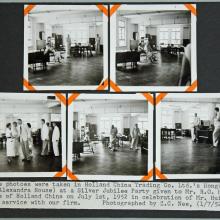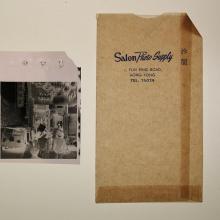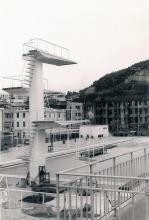Charles Gesner van der Voorts' friend Phil Beekmeijer started to work for Holland-China Trading Company (HCHC) in January 1940, joined the military, became one of the Netherlands first commandos, returned to China to work for HCHC in Tientsin (Tianjin) and had his first leave after ten years, in 1950. Usually, HCHC employees received half a year leave after four years abroad.
The last year in Tientsin (Tianjin) was difficult: fighting between the nationalist and communist armies came frightfully close: moments after leaving their home, the house received a full hit by a bomb.
After the leave, Phil Beekmeijer continued his service for HCHC in the Hong Kong office.
The photo has some interesting details:
on the airplane, the name of the airline company can be found: Braathens South American & Far East Airtransport A/S. I could not read Braathens but a search on the internet returned a page on wikipedia.org:
Braathens South American & Far East Airtransport A/S or Braathens SAFE was founded by ship-owner Ludvig G. Braathen in 1946. It started as a charter airline based at Oslo Airport, Gardermoen in Norway, flying to destinations in the Far East and in South America. At first the airline used Douglas DC-4s, and later also Douglas DC-3s. In 1948, the airline moved to Oslo Airport, Fornebu and started regular scheduled flights to the Far East.
Braathens South American & Far East Airtransport A/S was founded on 26 March 1946 by Ludvig G. Braathen through his shipping company Braathens Rederi. Share capital was 4 million kr, plus loans from the shipping company. Braathens had made good money during World War II with the participation in the Norwegian Shipping and Trade Mission, and received permission to use US$1 million to purchase aircraft. The idea to start an airline had occurred to Braathen in 1936, when the ship Brajara had engine trouble while en route to Japan. The Japanese shipyards could not guarantee that they could repair the ship, and at first it was considered whether the ship should be towed to Europe for repairs. The solution chosen was instead to have the necessary piece made in Amsterdam and flown by KLM. Braathen wanted to have an airline that would be able to fly crew and supplies to his and other ships throughout the world—primarily in the Far East.
Braathen traveled to the United States, where he bought several used Douglas C-54 (DC-4) aircraft from the United States Air Force. These were rebuilt by Texas Maintenance Company (Temco) in Fort Worth, Texas, giving them a capacity of 44 passengers, or 22 passengers and 4 tonnes (3.9 long tons; 4.4 short tons) of cargo. Twenty pilots were recruited and sent to Fort Worth for certification. The first plane, LN-HAV Norse Explorer, landed at Oslo Airport, Gardermoen on 26 December 1946. The next planes were LN-HAT Norse Skyfarer on 11 February 1947 and LN-NAU Norse Trader on 13 March.
The first route ran from Oslo to Cairo via Copenhagen and Paris on 30 January 1947. Afterwards, the company was chartered for several trips from Paris and Marseille, France, to Lydda, Palestine, and Tunis, Tunisia. From Lydda, the aircraft were used to evacuate French and British personnel prior to the creation of Israel. The company's route to Hong Kong was the longest air route in the world. At the time, the only scheduled service to the Far East was operated by British Overseas Airways Corporation using Sandringham flying boats. This route took a fortnight, while KLM had a land-plane route from Amsterdam to Batavia (Djarkarta). The first Braathens SAFE flight was made on 24 February from Oslo, landing at Amsterdam, Marseille, Cairo, Basra, Karachi, Culcutta and Bangkok before Hong Kong, where Norske Skyfarer landed on 8 March. Total flight time was 46 hours. Along the route, Braathens SAFE established contracts with agents, or stationed their own employees.
Courtesy Beekmeijer family archives




